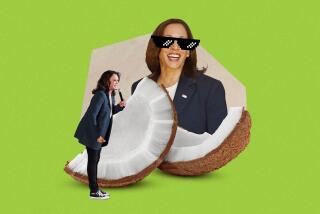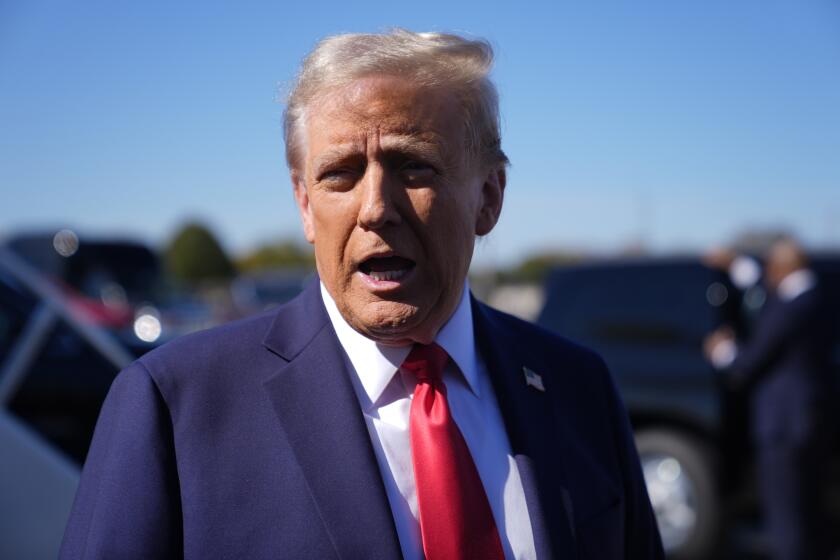Analysis:: For Clinton and Trump, first debate could be a last chance to sway voters. No pressure

Donald Trump and Hillary Clinton face-off on the debate stage for the first time tonight. Hereâs what to expect. Read more>>
Reporting from Hempstead, N.Y. â Hillary Clinton and Donald Trump step onto the biggest shared stage of their presidential campaign Monday chasing the same goal: persuading voters to discard long-held and sharply negative views of them.
Trump faces the biggest task in this first presidential debate, to accomplish in one night what he has not been able to pull off in 15 months: demonstrating to voters beyond his core supporters that he would be a stable and credible occupant of the White House.
Clintonâs task is just slightly less imperative, and only because of the narrow edge in most polls that she has held on to leading into the debate.
She needs to break through votersâ perceptions of her as untrustworthy and convince them that her years of political experience are matched by a gut-level understanding of the fears and concerns of everyday Americans.
Two groups will be foremost in the candidatesâ sights: college-educated suburbanites who usually vote Republican but have been reluctant to side with Trump, and Democratic-leaning younger voters who threaten to spurn Clinton for minor-party candidates Gary Johnson and Jill Stein, who will not be onstage.
Those deviations from typical political alliances, coupled with fresh divisions among blue-collar workers, have created a presidential contest whose momentum has flipped back and forth, denying either candidate a lasting lead.
âDebates and convention speeches are the kinds of events where voters open their points of view and come in and are ready to listen,â veteran Democratic pollster Peter Hart said.
âFor Donald Trump,â he said, âitâs not how clever he is or how bombastic. Itâs a question of âIs he serious?â Does he have the right temperament to be president?ââ
As for Clinton: âPeople know that she is safe in terms of temperament and safe in terms of knowledge and ability,â Hart said. âThey are only trying to answer one question: âCan I relate to her or, in reverse, can she relate to me?â â
A definitive win by one candidate in the debate â 43 days before election day â could reshape the race with very little time left to alter the new trajectory in the places that matter. Early voting begins Thursday in Iowa and Oct. 12 in Ohio, with other important states opening balloting a week later.
The race âdoesnât seem to be shifting based on policy positions; it seems to be shifting based on the temperament of the candidate,â Monmouth University pollster Patrick Murray said. âAnd thatâs why these debates are so important.â
In a race as riotous as this one, voters have had few opportunities since the primary season to ponder the candidates.
In just the last 10 days, the contest has been rocked by Trumpâs effort to put an end to his five-year quest to prove that President Obama was foreign-born, startling terrorist attacks in three states and days of violence in Charlotte, N.C., after a police shooting of an African American man. Barely have candidates responded to one crisis before another erupted.
Those events have offered a clear look at the opposite approaches the candidates probably will bring to the stage during the 90-minute, nationally televised gathering at Hofstra University here amid New Yorkâs Long Island suburbs. (Two other presidential debates and one vice presidential gathering will be held before Oct. 19.)
Clinton has responded with reserved words and multi-part plans, Trump with broad assertions that itâs time to get tough.
Until now, however, their conflict has been long distance; placing the candidates next to each other, with millions watching, will provide a more probing measurement of both.
What do undecided or unpersuaded voters want to see from that matchup?
âNot what they have,â said Republican pollster Whit Ayres.
âGiven the level of disgust with both candidates, itâs hard to pinpoint any one factor that would make many people feel a lot better about either one,â he said.
Far more voters are either undecided or siding with minor-party candidates this year than at comparable times in previous presidential elections. Typically, interest in alternative candidates drops as election day nears and voters focus on those more likely to inhabit the White House.
Yet given the distaste for both candidates, it is not clear whether that tradition will hold. That is particularly true for younger voters, many of whom sided with Sen. Bernie Sanders in the Democratic primaries.
Sanders has been campaigning for Clinton among those voters, but many have been reluctant to embrace her as they once did Obama.
âHow those voters view the debate becomes terribly important,â Hart said, setting them as Clintonâs top goal.
âIs it simply a reaffirmation that âI canât stand these two candidates,â or is it a situation of âI know I hate Trump, but I can handle Hillary Clintonâ?â
The corollary for Trump is finding some way to appeal to the overlapping voting groups that so far have disdained him: suburban voters, college-educated whites and women. They make up a growing share of the vote, to his peril, in key states such as Pennsylvania and Virginia, which make up Clintonâs election firewall.
Election 2016 | Live coverage on Trail Guide | Sign up for the newsletter | The race to 270
A NBC News/Wall Street Journal poll released Wednesday illustrated the difficulty for Trump in attempting to overcome what that survey pegged as a 6-percentage-point Clinton advantage among voters likely to cast ballots this fall. (Trump has picked up ground in some important states, but Clinton retains more options to getting to 270 electoral college votes.)
Among women, the NBC/WSJ poll found, Clinton held a 14-point lead; among white voters with college educations, she led by 6. Trump led by a narrow 2 points among men and 18 points among white voters without a college education, not quite enough to overcome Clintonâs strengths.
Yet the conflicts that have left some voters undecided or looking elsewhere were evident when the poll plumbed views about the campaignâs many controversies.
Almost 7 in 10 voters said they were concerned about Trumpâs criticisms of women, immigrants or Muslims, criticisms that Clinton has hammered in ads in key states. Two-thirds believed that Trump lacked the temperament necessary in a president.
When it came to Clinton, almost two-thirds of voters said they were concerned about her use of a private email server during her tenure as secretary of State; more than 6 in 10 were critical of her judgment regarding overseas conflicts.
Worries about Clinton and Trump have prompted near-despondency among some voters.
At an upscale shopping mall in a suburb of Columbus, Ohio, several days ago, some threw up their hands about their options.
âI donât feel 100% great about either one of them,â said Juanetta Burch, 36, of Westerville, one of a ring of suburbs sought after by both campaigns.
She lamented the tone and focus of the campaign that she said has left voters like her bewildered about what each candidate would do if elected.
âAll of the unimportant things are pushed forward,â she said. âAll of the important things get lost in all of the nonsense.â
Like Burch, Omeliah Nembhard, sitting in another part of the mall with her 9-month-old daughter, Kohlyn, said she was leaning toward Clinton because she was offended by Trump. But Nembhard, who is 21, was not thrilled about it.
âI donât really feel like itâs going to make a difference,â she said of the election. âThe less worse one is the winner.â
Twitter: @cathleendecker
ALSO:
How the candidates are preparing for Mondayâs debate
Even the swing states where Trump and Clinton are tied arenât enough to hand him a win
More political analysis from Cathleen Decker
Trail Guide: live coverage of the campaign
More to Read
Get the L.A. Times Politics newsletter
Deeply reported insights into legislation, politics and policy from Sacramento, Washington and beyond. In your inbox three times per week.
You may occasionally receive promotional content from the Los Angeles Times.









